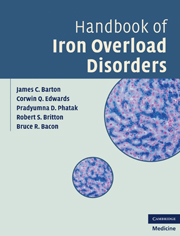Book contents
- Frontmatter
- Contents
- Foreword by Anthony S. Tavill
- Preface
- 1 History of iron overload disorders
- 2 Normal iron absorption and metabolism
- 3 Iron toxicity
- 4 Tests for hemochromatosis and iron overload
- 5 Complications of hemochromatosis and iron overload
- 6 Insulin resistance and iron overload
- 7 Infections and immunity
- 8 Classical and atypical HFE hemochromatosis
- 9 Heterozygosity for HFE C282Y
- 10 Porphyria cutanea tarda
- 11 Mitochondrial mutations as modifiers of hemochromatosis
- 12 Hemochromatosis associated with ferroportin gene (SLC40A1) mutations
- 13 Hemochromatosis associated with hemojuvelin gene (HJV) mutations
- 14 Hemochromatosis associated with hepcidin gene (HAMP) mutations
- 15 Hemochromatosis associated with transferrin receptor-2 gene (TFR2) mutations
- 16 Iron overload associated with IRE mutation of ferritin heavy-chain gene (FTH1)
- 17 Hereditary hyperferritinemia-cataract syndrome: IRE mutations of ferritin light-chain gene (FTL)
- 18 Iron overload in Native Africans and African-Americans
- 19 Hereditary atransferrinemia
- 20 Divalent metal transporter-1 (SLC11A2) iron overload
- 21 Iron overload associated with thalassemia syndromes
- 22 Iron overload associated with hemoglobinopathies
- 23 Iron overload associated with pyruvate kinase deficiency
- 24 Iron overload associated with congenital dyserythropoietic anemias
- 25 Hereditary sideroblastic anemias
- 26 Pearson marrow–pancreas syndrome
- 27 Acquired sideroblastic anemias
- 28 Hereditary aceruloplasminemia
- 29 Friedreich ataxia and cardiomyopathy
- 30 Pantothenate kinase (PANK2)-associated neurodegeneration
- 31 Neuroferritinopathies
- 32 GRACILE syndrome
- 33 Neonatal hemochromatosis
- 34 Iron overload due to excessive supplementation
- 35 Localized iron overload
- 36 Management of iron overload
- 37 Population screening for hemochromatosis
- 38 Ethical, legal, and social implications
- 39 Directions for future research
- Index
- Plate section
- References
30 - Pantothenate kinase (PANK2)-associated neurodegeneration
Published online by Cambridge University Press: 01 June 2011
- Frontmatter
- Contents
- Foreword by Anthony S. Tavill
- Preface
- 1 History of iron overload disorders
- 2 Normal iron absorption and metabolism
- 3 Iron toxicity
- 4 Tests for hemochromatosis and iron overload
- 5 Complications of hemochromatosis and iron overload
- 6 Insulin resistance and iron overload
- 7 Infections and immunity
- 8 Classical and atypical HFE hemochromatosis
- 9 Heterozygosity for HFE C282Y
- 10 Porphyria cutanea tarda
- 11 Mitochondrial mutations as modifiers of hemochromatosis
- 12 Hemochromatosis associated with ferroportin gene (SLC40A1) mutations
- 13 Hemochromatosis associated with hemojuvelin gene (HJV) mutations
- 14 Hemochromatosis associated with hepcidin gene (HAMP) mutations
- 15 Hemochromatosis associated with transferrin receptor-2 gene (TFR2) mutations
- 16 Iron overload associated with IRE mutation of ferritin heavy-chain gene (FTH1)
- 17 Hereditary hyperferritinemia-cataract syndrome: IRE mutations of ferritin light-chain gene (FTL)
- 18 Iron overload in Native Africans and African-Americans
- 19 Hereditary atransferrinemia
- 20 Divalent metal transporter-1 (SLC11A2) iron overload
- 21 Iron overload associated with thalassemia syndromes
- 22 Iron overload associated with hemoglobinopathies
- 23 Iron overload associated with pyruvate kinase deficiency
- 24 Iron overload associated with congenital dyserythropoietic anemias
- 25 Hereditary sideroblastic anemias
- 26 Pearson marrow–pancreas syndrome
- 27 Acquired sideroblastic anemias
- 28 Hereditary aceruloplasminemia
- 29 Friedreich ataxia and cardiomyopathy
- 30 Pantothenate kinase (PANK2)-associated neurodegeneration
- 31 Neuroferritinopathies
- 32 GRACILE syndrome
- 33 Neonatal hemochromatosis
- 34 Iron overload due to excessive supplementation
- 35 Localized iron overload
- 36 Management of iron overload
- 37 Population screening for hemochromatosis
- 38 Ethical, legal, and social implications
- 39 Directions for future research
- Index
- Plate section
- References
Summary
In 1922, German investigators Hallervorden and Spatz reported a syndrome of neurologic and pathologic findings in a sibship of 12 individuals, among whom 5 siblings had progressive dysarthria and dementia. At autopsy, the investigators observed brown discoloration of the substantia nigra and the globus pallidus of the affected siblings. Since the initial report, hundreds of individuals with this disorder have been reported, and most have mutations of the PANK2 gene that encodes pantothenate kinase 2. In 2001, this disorder was named pantothenate kinase-associated neurodegeneration, also known as neurodegeneration with brain iron accumulation (OMIM #234200). The brown discoloration of the brains of persons with pantothenate kinase-associated neurodegeneration is caused by the deposition of excessive quantities of iron. This condition occurs in approximately 3 per 1,000,000 people. In a university hospital autopsy series that was evaluated to identify iron overload disorders specifically, only one case of neurodegeneration with brain iron accumulation was found in 10,345 adults (age ≥21 years) and 1337 children (>1 year of age).
Clinical manifestations
There is phenotypic heterogeneity in the clinical presentation of patients who have mutations of the PANK2 gene. The report of an international study published in 2003 describes findings in 186 patients from 145 families, including clinical histories, physical examination findings, laboratory characteristics, extrapyramidal neurologic abnormalities, and magnetic resonance imaging evidence of iron deposition in the basal ganglia.
- Type
- Chapter
- Information
- Handbook of Iron Overload Disorders , pp. 294 - 298Publisher: Cambridge University PressPrint publication year: 2010



